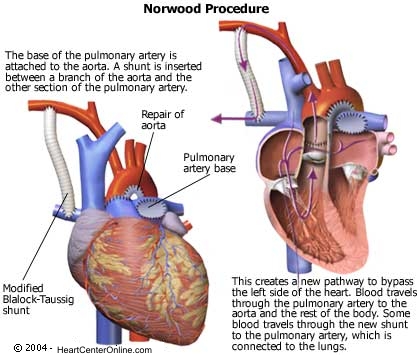|

|
Norwood Operation

The Norwood Operation Summary
The Norwood procedure is a series of three open-heart surgeries that gradually improve certain life-threatening forms of congenital heart disease. It is used most often to treat hypoplastic left heart syndrome, but variations of the procedure may also be used to treat other congenital heart diseases in which one or both of the lower chambers of the heart (ventricles) are defective. Each of the three surgeries is done at a different age, beginning from infancy and spanning through the toddler years. The first two surgeries (Stage I and Stage II) are used to temporarily relieve blood flow problems to and from the lungs. The third surgery (Stage III) is used to further improve circulation. The Norwood procedure cannot cure the underlying heart defects.
The Norwood procedure re-routes the blood flow around some of the defective areas of the heart by creating new pathways for blood circulation to and from the lungs. Despite the complexity of the procedure, many children go on to live a relatively normal lifestyle after completing all three stages.
The most common heart defects that are treated by the Norwood procedure are:
Hypoplastic left heart syndrome (HLHS). Some types of tricuspid atresia.
Various other faulty connections among the upper and lowers chambers of the heart, resulting in the heart’s inability to maintain good blood circulation throughout the body.
Norwood Sano Procedure
|